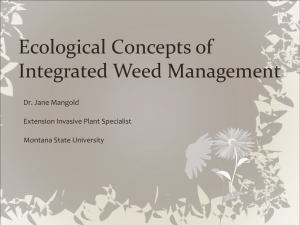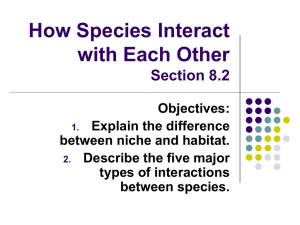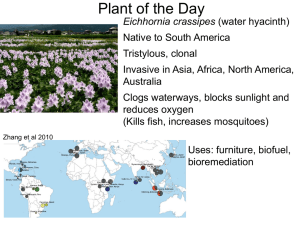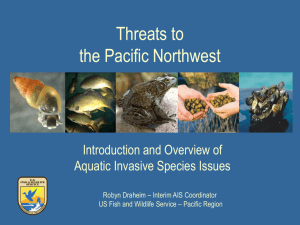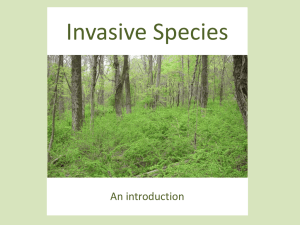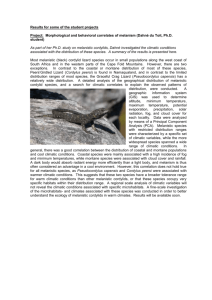Biogeography
advertisement
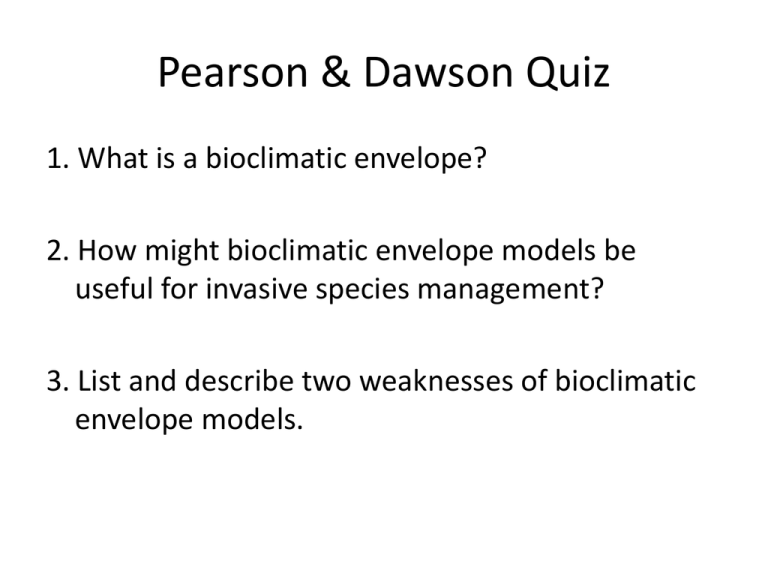
Pearson & Dawson Quiz 1. What is a bioclimatic envelope? 2. How might bioclimatic envelope models be useful for invasive species management? 3. List and describe two weaknesses of bioclimatic envelope models. Pearson & Dawson Quiz 4. What is equilibrium in the context of bioclimatic envelope modeling? Do you think disequilibrium is likely to be a problem for modeling invasive species? 5. In addition to climate, what other environmental variables are likely important for the distribution of species? Chinese mitten crab (Eriocheir sinensis) Exam Review Definition of an invasive species • Non-native • Capable of surviving without direct help from people (established or naturalized) • Spreading away from sites of initial establishment • Often with negative ecological and economic consequences Lockwood et al., 2007 Are resource opportunities from global change likely to be evenly or unevenly distributed globally? Give an example of an ecosystem or location at high risk of invasion due to higher resources Anthropogenic global changes: - Climate change - Nutrient addition - Invasive species - Habitat loss (disturbance & degradation) At Risk: Ecosystems with scarce resources • If resources are limited, native species are adapted to scarcity • Anthropogenic addition of resources creates new ‘empty’ niches Biogeography Definition: • Understanding more about a species by using information from where the species is located Examples: – In what range of temperatures does the species establish? (Physiological tolerance) – Is the species located near human activity? (Disturbance responsive) What affects invasive species spread? What affects invasive species spread? Species Traits: • Dispersal ability • Fecundity (number of seeds or offspring) • Wide environmental tolerance • Fast generation time (early sexual maturity) • Generalist What affects invasive species spread? Environmental Factors: • Disturbance • Climatic suitability • Other environmental suitability (soils, nutrients, prey) • Dispersal corridors (environmental connectivity) • Dispersal vectors (e.g., seed carriers) Climatic Similarity Predicts Invasion Significant Predictor of Establishment Characteristic # Datasets Characteristic # Datasets Significant Predictor of Invasion Hayes & Barry, 2008 Similar climatic regions Similar climatic regions Biogeographical Modeling of Species Potential Distributions Relevant to invasive species because it can potentially predict invasion risk BEMs use biogeography to empirically determine climatic tolerance Problem: Equilibrium Assumption • Assumes a species is at equilibrium with its environment (it exists everywhere that it could exist) • The equilibrium assumption FAILS for invasive species • Invasives are still spreading… Evidence of an equilibrium problem At early stages of invasion (upper left), models of potential suitability are incomplete. Only at later stages of invasion (lower right), when the species has had time to spread, can models encompass environmental suitability Vaclavik & Meentmeyer, 2011 A way around the equilibrium problem? Use the native range to predict invasion Only 7 out of 50 invasive plant species tested had invaded ranges that exceeded the climatic conditions of their native ranges by more than 10% Climatic Space Less than 10% of A+B Petitpierre et al., 2012 Climate matching Carpobrotus edulis (ice plant) Native to South Africa Thuiller et al., 2005 Realized vs. Fundamental Niche Fundamental Niche: • All the environmental conditions in which a species can survive. Realized Niche: • Fundamental niche minus dispersal limitations & competition with other species. Climatic Space Realized Niche Invaded Range Realized Niche Native Range Fundamental Niche Use climatic conditions from all native and invaded range to define fundamental niche Kriticos et al., 2011 Another Approach: Use Species’ Physiological Tolerance Physiological Tolerance to Extremes Survival (%) Responses of 7 grass species to a heat wave of +11°C Heat wave duration (days) Milbau et al. 2005 Use physiological characteristics to model potential geographic range Buckley, 2008 Biogeography team task 1. What are the spatial extents of invasion risk for your target species? 2. How do the results of a bioclimatic envelope model differ from an assumption based on physiology? Biogeography team task Biogeography team task Reading assignment for Thursday: Find and read one paper (use Google Scholar or Web of Science!) describing the physiological tolerance or climatic limits of your target species. Search examples: Genus species + temperature tolerance, freezing tolerance, physiological limitation, heat stress, climatic limitation Species of the day: Caulerpa taxifolia “Killer Algae” • Forms dense, monotypic stands • Crowds out native vegetation • Toxic to herbivores • Affects behavior of fish & other organisms Impacts on (one example) fish Mullus surmuletus activity in the Mediterranean C. taxifolia: Established Not Established Levi and Francour, 2004 Popular aquarium algae • Cold-tolerant strain developed in 1980 at an aquarium in Stuttgart • Cold-tolerant strain shared with aquariums in Nancy, Geneva & Monaco • Monaco aquarium likely source of release into the Mediterranean Jousson et al., 1998 Invasive strains are genetically identical to the aquarium strain Branches of the tree denote genetic difference ‘Aquarium strain’ also found off the coasts of Australia and Southern California ‘Aquarium strain’ likely tolerant of lower temperatures than species in native range Jousson et al., 1998 Pearson & Dawson, 2003 Why do you think BEMs only include climate? Why not include biotic interactions?
